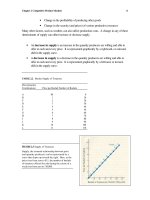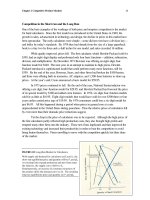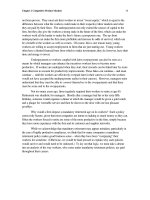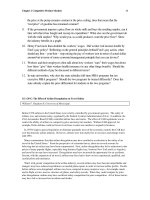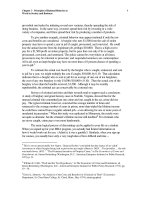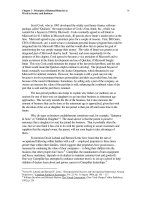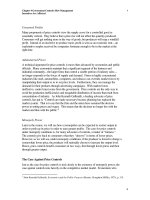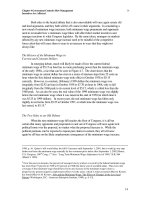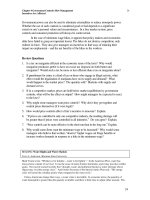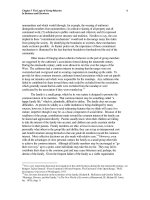Tài liệu Microeconomics for MBAs 23 pptx
Bạn đang xem bản rút gọn của tài liệu. Xem và tải ngay bản đầy đủ của tài liệu tại đây (40.1 KB, 10 trang )
Chapter 6. Reasons for Firm Incentives
39
workers. The demand curve in Figure 6.2 drops down vertically by the per-worker cost of the
fringe, from D
1
to D
2
. This happens because the firms are simply not willing to pay as high a
wage to their workers if they have to cover the cost of the fringe. On the other hand, the supply
of workers shifts outward, from S
1
to S
2
, because work is now more attractive because of the
fringe, leading to more workers applying for jobs. Workers are willing to work for a lower
money wage when the fringe is provided (and, again, for simplicity we assume that each
worker values the fringe by the same amount). The vertical difference between S
1
and S
2
represents how much each worker values the fringe and is willing to give up in their wage rate
for the fringe; this vertical difference is a money measure of the value of the fringe to workers.
What happens, given these shifts in supply and demand? As can be seen in the figure,
the market-clearing wage falls from W
1
to W
2
. Are workers and firms better off? Well, a close
examination of the figure reveals that more workers are employed (Q
2
instead of Q1), which
suggests that something good must have happened. Otherwise, we must wonder why firms
would want to hire more workers and more workers would be willing to be employed. It just
doesn’t make much sense to argue that firms and/or workers aren’t better off when both sides
agree to more work (and when the fringe is provided voluntarily).
Notice that the total cost of the fringe, the vertical distance between the two demand
curves, or bc, is less than the reductions in the wage, W1-W2, from which we can draw two
implications: First, the firm is clearly making money off its original employees (W
2
+ bc is less
than W
1
). Second, the firm’s total cost per worker (W
2
+ bc) falls, which explains why they are
willing to expand their hires.
Notice also that while the workers accept a lower wage rate, W
2
instead of W
1
, they
gain the value of the fringe, which in the graph is the vertical distance ac. The sum of the new
lower wage, W
1
, plus the value of the fringe, ac, is W3, which is higher than the wage without
the fringe (W
2
+ ac = W
3
> W
1
). Ergo, both sides gain.
How much of the fringe benefit should be provided? It would be nice if we could tell
each person reading this book exactly what to do. It would be silly to try, given the variation of
business and market circumstances. What we can do is look to rules that are generally
applicable. The rule the firms should follow is no different than the rule they should follow in any
other productive market circumstance: Firms should continue to expand the fringe so long
as the added cost from the fringe is less than the reduction in their wage bills, which can
be no greater than the workers’ evaluation of the fringe.
For example, the number of days of paid vacation should be extended so long as the
value workers place on additional vacation days is greater than the marginal cost to the
employer of providing the additional day. Given that workers’ evaluation of each additional day
will fall (at least after some number of days) and the cost of the additional day will rise, after
some number of days off, a point will be reached beyond which equality between the additional
cost of the next vacation day will exceed its marginal value (or the possible reduction in the
Chapter 6. Reasons for Firm Incentives
40
wage bill). At that point, employers have maximized their profit from “selling” the fringe to their
workers.
Of course, tax rules will affect the exact amount of the fringe, as well as the
combination. Certainly, if fringe benefits -- for example, health insurance -- are not subject to
taxation, then employers should, naturally, provide more of them than otherwise, simply because
part of the cost of the benefit is covered by a reduction in worker taxes. The result might be
that workers actually get more of the benefit than they would buy, if they were covering all of
the cost themselves. Still, the employers must provide the benefit; otherwise, they will not
keep their compensation costs competitive with that of rival employers.
Optimum Fringes
We expect employers and workers to treat fringes like they do everything else, seeking some
optimum combination of fringes and money wages. Again, this means that employers and
workers should be expected to weigh off their additional (or marginal) value against their
additional (or marginal) cost. An employer will add to a fringe like health insurance as long at
the marginal value (measured in money wage concessions or increased production from
workers) is greater than the marginal cost of the added fringe. Similarly, workers will “buy”
more of any fringe from their employer so long as its marginal value (in terms of improved health
or reduction in the cost of private purchase) is greater than its marginal cost (wage concessions).
While we can’t give specifics, we do know that managers are well advised to search
earnestly for the “optimum” combination (which means some experimentation would likely be in
order) even though the process of finding the optimum is beset with imprecisions. The firms that
come closest to the optimum will be the ones that can make the most money from their
employees. They will also be the ones that provide their employees the most valuable
compensation for the money spent -- and so will have the lowest cost structure and be the most
competitive. By trying to make as much money as possible from their employees, firms not only
stay more competitive, they also benefit their workers as well.
So far, we have considered only fringes in which the added cost of the fringe to the firm
is less than the value of the fringe to the workers. What if that were not the case? Returning
attention to Figure 6.2, suppose that the cost of the fringe to firms were greater than the value of
the fringe to workers (in the graph, the distance bc is greater than the distance ac), what would
happen? The straight answer: Nothing. The fringe would not be provided. The reason is
obvious: Both sides, workers and owners, would lose. The resulting drop in the wage would be
less than the cost of the fringe to the employers, and the resulting drop in the wage would be
greater than the value of the fringe to the workers. (To see this point, just try drawing a graph
with the vertical drop in the demand greater than the outward shift of the supply.) Such a
fringe would not -- and should not -- be provided simply because it is a loser to both sides.
Chapter 6. Reasons for Firm Incentives
41
Firms that persisted in providing such a fringe would have difficulty competing, simply
because their cost structure would be higher than other producers. Such firms would be subject
to takeovers. The takeover would very likely be friendly because those bidding for the firm in
the takeover would be able to pay a higher price for the stock than the going market price,
which would be depressed by the fact that one or more fringes provided to workers was not
profitable. Those involved in the takeover could, after acquiring control, eliminate the
excessively costly fringe(s) (or reduce it to profitable levels), enhance the firm’s profitability and
competitive position, and then sell the firm’s stock at a price higher than the purchase price.
54
The workers would support such a takeover -- and might be the ones managing the
takeover -- because they could see a couple of advantages: They could have a fringe eliminated
that is not worth to them the cost that they would have to pay in terms of lower wages. They
could also gain some employment security, given the improved competitive position of their firm.
The workers might even take the firm over for the same reason anyone else might do so: They
could improve the firm’s profitability and stock price.
Fringes Provided by Large and Small Firms
We can now understand why it is that so many large firms provide their employees with health
insurance and so many small firms do not. At the most general level, it simply pays large firms
to provide the insurance, while it doesn’t pay for the small firms to do so. Large firms can sell a
large number of health insurance policies, achieving economies associated with scale and of
spreading the risks. That’s a widely recognized answer.
At another level, the answer is more complicated and obscure. “Small” and “large”
firms do not generally hire from the same labor markets. Small firms tend to provide lower
paying jobs. The workers in lower paying jobs within small firms simply don’t have the means
to buy a lot of things that workers in larger firms have, and one of the things workers in small
firms don’t seem to buy in great quantities is insurance. Given their limited income, workers
simply don’t think that insurance is a good deal, and they would prefer to buy other things with
higher monetary compensation. One of the reasons low-income workers may gravitate to small
firms is that they shy away from large firms where they would have to give up wages to buy the
insurance, because of company policies that apply to all workers.
Of course, the analysis gets even trickier when it is realized that lower income workers,
many of whom work for small firms, tend to be younger workers -- who also tend to be
healthier and in need of a different combination of fringes than older workers. The young can
appreciate that the price they would have to pay for health insurance through their firms is
54
Engaging in a takeover can be very expensive, and we recognize that a firm is not likely to be taken over
because of the failure of the firm to provide one efficiency-enhancing fringe benefit. But when enough of
these types of mistakes are made, the inefficiency mounts, increasing the chance that the firm will be a
takeover target.
Chapter 6. Reasons for Firm Incentives
42
inflated by a number of factors related to supply and demand. First, the price of health
insurance has been inflated by a host of cost factors, not the least of which is the increased
liability doctors face for virtually anything that goes wrong with patients when they are under the
doctors’ care. The radical application of expensive medical technologies to care for older dying
patients has also jacked up the cost of insurance and care for the young.
Second, older workers, many of whom are in large firms and tend to have a strong
demand for health insurance, have increased the demand for insurance (and health care). The
exemption of health insurance from taxable income (which helps higher income workers more
than lower income workers) has also artificially inflated the demand for health insurance (and
health care). The net result of the cost and demand effects has been to increase health insurance
costs, making the insurance an unattractive deal for many young and low-income workers, many
of whom work for small firms.
We know the objections to our line of analysis. Critics might say that we have
overlooked the human factor. Fringe benefits are important to workers, and they should have
fringe benefits even when they aren’t profitable. We see a couple of problems with that claim.
If the fringe were as important as claimed, then surely workers would be willing to give up a lot
for it. The problem is that the cost may be greater than the benefit. If workers are forced to
take a fringe because it is “important,” then they could be forced to pay more for something than
it is worth to them. We can’t quite understand the logic of forcing people to “buy” something
that they do not believe is worth the cost. There are lots of things that people think are
important for other people to have. But typically it is best to let individuals decide for
themselves how much of these important things they buy with their own money. Individuals
have information on their own preferences and circumstances that others do not know, and
cannot know.
Critics might like to think that employers would pay for any given benefit. If the analysis
of this section has led to any clear conclusion, it is that that the workers pay for what they get.
They may not hand over a check for the benefits, but they give up the money nonetheless,
through a reduction in their pay. If workers didn’t give up anything for the fringe, we would
have to conclude that the benefit was not worth anything to the workers, the supply curve would
not move out, and the wage rate would not fall. That would mean that the employers would
have to cover the full cost of the fringe, which would put them in the rather irrational position of
adding to their costs without getting anything for it. Workers should not want that to happen if
for no other reason than their job security would be threatened.
But critics might argue that managers don’t know that certain fringes are “good” for
business and their workers. That is often the case, and the history of business is strewn with the
corpses of firms that failed to serve the interests of their workers and customers and who were
forced into bankruptcy by other firms who were better at finding the best combination of fringes.
We see the market as a powerful, though imperfect, educational system. If the critics know
better than existing firms, they could make lots of money by pointing out to firms why they are
Chapter 6. Reasons for Firm Incentives
43
wrong and how they could make money from their employees by providing (selling) fringes not
now being provided, or adjusting the combination of existing fringes in marginal ways.
We also don’t believe that managers are the only ones who should search for the right
combination of fringes. Workers should have an interest in joining the search, because they can
gain in spite of the fact that their efforts will include a search for how their firms can make more
money off them. If workers want more of one benefit, it would seem that all they would have to
do is tell their bosses and show them how additional profits can be made from the workers.
Workers, however, who want benefits without paying for them shouldn’t waste their bosses’
time. Managers hear from a lot of people who want something for nothing.
We think that workers and owners should talk as frankly about fringe benefits as they
do about their wages. Workers earn their wages. The same is true for fringes. There’s no gift
involved. Both wages and fringes represent mutually beneficial exchanges between workers and
their firms.
MANAGER’S CORNER: Why Some Firms
Pay for Their Employees’ MBAs
Education is sometimes said to be a good that stands in contrast with our road example. An
educated person can provide others with whom he or she interacts with benefits. Lee and
McKenzie can work together on this book in part because the other is “educated,” meaning at
its most fundamental level each can write and read what the other writes. Each benefit from the
other’s education, but neither contributed directly to the other’s education expenses. One
argument for government subsidies for education has been that because people who acquire
education don’t garner all the benefits from their education, then they will buy “too little”
education, or extend their education only so long as their personal benefits were greater than
their personal cost, which could mean that without the ability to communicate, much productive
work would not be done.
This argument may hold for elementary and high school education, where the
development of basic literacy is important, but it may not hold at the MBA level when
practically all of the benefits seem to be private, meaning received by identified people, not
public, meaning received by everyone in the broader community.
In this “Manager’s Corner,” we can extend our use of economic thinking to understand
why firms behave the way they do. We start by noting that firms pay for some things for their
workers but not other things. Why? We consider here an employee expense – an MBA
education – that is sometimes covered and sometimes not covered by firms (consider the
people in class). We also note that there is good reason to think that either the students or their
firms should pay for the MBA education; the benefits are captured by the two groups. Our
examination of these issues will help us draw out underlying principles, and the incentives that go
with employer coverage of other work-related expenditures, not just education.
